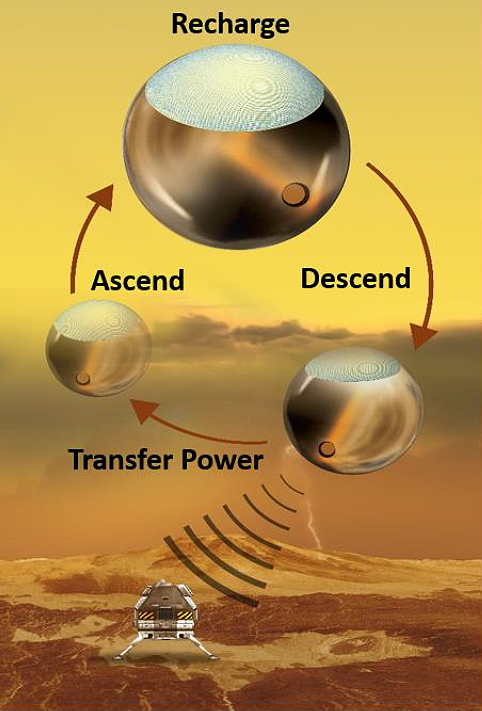Erik Brandon
NASA Jet Propulsion Laboratory
NIAC 2019 Phase I Brandon Powerbeaming
A new approach to support long duration Venus surface missions will be investigated, which will address the difficult challenge of surface power generation in such an extreme environment. The key mission concept centers on the use of a dual vehicle architecture—one vehicle is a high altitude platform that provides power generation in the more forgiving upper atmosphere of Venus, the other
vehicle being a lander that stores and uses the generated power to execute the mission. These two spacecraft (and spacecraft functions) are tied together via an innovative power beaming system.
Power beaming (also known as wireless energy transfer) is a means for transmitting electrical energy through various media (i.e., vacuum, air, water) via electromagnetic energy. In this case, a transmitter located on an atmospheric platform (power generation side) would beam power to a receiver (lander energy storage) through the carbon dioxide atmosphere. For a Venus mission, this would require transmitting power at radio frequency (rf) or microwave wavelengths, due to the presence of extensive cloud cover that would block optical/laser based power transfer methods. The variable altitude atmospheric platform (e.g., balloon), would descend to the lower altitudes of the atmosphere, to transmit power from its on-board high temperature batteries to high temperature batteries on the lander. On both the atmospheric platform and the lander, either high temperature molten salt or solid electrolyte batteries, or even a solid oxide regenerative fuel cell system, would serve as the energy storage medium. The transmitted rf energy would be converted to direct current electrical power on the lander via a rectifying antenna or “rectenna” constructed from suitable high temperature
materials and using high temperature SiC diodes. The specific altitude for the atmospheric platform would be chosen to optimize efficient energy transfer while minimizing exposure to the most extreme temperatures found immediately above the surface.
Once the energy from the batteries on the atmospheric platform was transferred to the lander, it would ascend to the upper reaches of the atmosphere where the solar flux is high, to recharge its batteries. Once these batteries were “topped off,” the entire sequence would repeat and the atmospheric platform would again descend to the lower reaches of the Venus atmosphere to transmit its stored energy to the lander batteries. This sequence would continue throughout the life of the lander. The landed element of the mission would continue to perform as long as its components or subsystems survived, without being limited by power. The variable altitude platform could continue a secondary science mission after the end of the landed element of the mission. During the course of the mission, the atmospheric platform could also serve as a communications relay between the Earth and the Venus lander, to support transmission of data and commands. This approach will bring together innovations in high temperature photovoltaics (which are feasible down to 20 km where solar fluxes are adequate) and high temperature rechargeable batteries (which can be used in the atmosphere and on the surface) in a new mission architecture to address the surface power challenge by separating the power generation and energy storage functions.
This approach has the potential to unlock the Venus surface power generation problem and offers a means for powering a long duration lander, unlike any previously proposed power technology solutions. The problem is solved by the novel deployment of several enabling technologies in a unique two-vehicle Venus mission architecture. This study will focus on development of a conceptual
system architecture which addresses all key elements of the mission. This includes the nature of the two spacecraft, the optimal power beaming parameters and the optimal atmospheric platform/lander distance to support the most efficient energy transfer.































